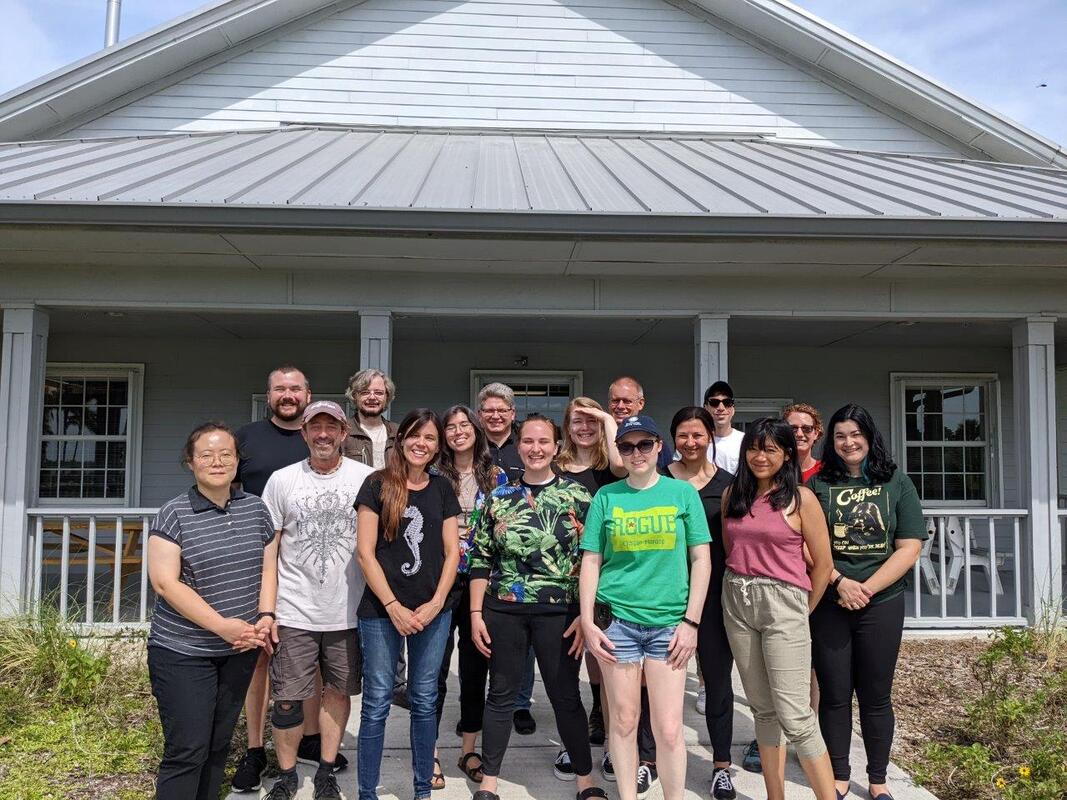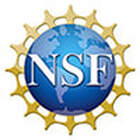2022 Smithsonian Marine Station (SMS) Meiofauna Diversity and Taxonomy Workshop
Dates: June 13-24, 2022
Location: Smithsonian Marine Station in Fort Pierce, FL
Cost: Free!
Application deadline: March 15, 2022
Organizers:
Kevin Kocot - University of Alabama, Tuscaloosa
Ashleigh Smythe - Virginia Military Institute
Mentors:
M. Carmen Cobo - University of Alabama - Meiofaunal Mollusca
Rick Hochberg - University of Massachusetts Lowell - Gastrotricha & Rotifera
Oleksandr Holovachov - Swedish Museum of Natural History - Nematoda & scientific illustration
Ulf Jondelius - Swedish Museum of Natural History - Acoela & (some) Platyhelminthes
Kevin Kocot - University of Alabama Tuscaloosa - Mollusca, Entoprocta, Hemichordata, & genomics
Francesca Leasi - University of Tennessee Chattanooga - Rotifera & metagenetics/metagenomics
Ashleigh Smythe - Virginia Military Institute - Nematoda
Holly Sweat - Smithsonian Marine Station - Benthic ecology
Torsten Struck - Natural History Museum (UiO) - Annelida & genomics
Colleagues in training:
Ariane Buckenmeyer - Swedish Museum of Natural History
Thainá Cortez - Universidade de São Paulo
Jess Glanz - Smithsonian Marine Station
Kimi Kim Ewha - Womans University
Regine Manglicmot - University of British Columbia
Penny McCowen - U.S. Geological Survey; University of Florida
Vanessa Pitusi - The University Centre in Svalbard
Alberto Valero-Gracia - Natural History Museum (University of Oslo)
Jo Vandyke - University of Massachusetts Lowell
Background:
The term "meiofauna" refers to tiny animals capable of passing through a ~0.5-mm mesh. Many meiofaunal animals are interstitial, meaning they burrow in marine sediments. Several entire phyla (such as kinorhynchs, gastrotrichs, and gnathostomulids), major clades of other invertebrate phyla (especially arthropods, nematodes, annelids and flatworms), and miniaturized representatives of most other animal phyla are meiofaunal. Meiofaunal animals have been estimated to account for half of the biodiversity in complex biotopes such as coral reefs, with most of it associated with sediments. While the great phylum- and class- level diversity of meiofauna is well-known, the species-level diversity remains largely unexplored and undocumented. By some estimates, the number of species of meiofaunal nematodes alone that waiting to be formally named dwarfs the number of already described meiofaunal species by two orders of magnitude. Morphological studies of meiofauna have led to groundbreaking insights about their evolution, adaptation, and functional biology (e.g., adhesive and sensory structures), as well as fundamental insights into the evolution of the major animal groups in the tree of life. More recently, advances in molecular biology ranging from DNA barcoding to metabarcoding to whole-genome sequencing have accelerated the pace of the study of all aspects of the biology of meiofauna.
Course description:
The overarching goal of this course is to help train the next generation of marine invertebrate taxonomists. Specifically, the course is designed to familiarize participants with the vast biodiversity of marine meiofauna through field and laboratory work. We will take a taxon-survey approach to emphasize the development or enhancement of practical skills essential for collection, identification, characterization, preservation, and molecular analysis of meiofauna. Sampling of diverse habitats near Fort Pierce (e.g., Capron Shoal and local beaches) and the Florida Keys (e.g., coral reefs, rubble fields, mangroves, and beaches) will provide a wealth of specimens of diverse taxa for our investigations. Note that SCUBA-certified participants will have the opportunity to dive recreationally in the Florida Keys at their own expense/risk, but the course will not involve scientific diving.
Morphological laboratory work will emphasize the preparation of specimens for microscopic examination and sorting to the level possible with light microscopy. Participants will have the opportunity to collect specimens of meiofaunal animals for their own research (if desired). Participants will also be expected to help compile and contribute specimens for DNA barcoding and transcriptome sequencing (see below), species lists, images, and metadata that will be released public databases.
Molecular laboratory work will include training in basic molecular lab skills and DNA barcoding for participants not already familiar with these techniques. Subsequently, participants will learn transcriptome (cDNA) and sequencing library preparation techniques that can be used on single meiofaunal animals. Each participant will have the opportunity to sequence at least one transcriptome of an organism of interest as part of the course (data will unfortunately not be available until after the course is over).
Due to space constraints, the course is limited to just 9 students. We use the term "student" broadly and will consider applicants at diverse career stages interested in studying meiofauna. Please note that more workshops are planned for other locations in the next couple of years so there will be other opportunities for applicants not able to join this workshop in the near future.
Location: Smithsonian Marine Station in Fort Pierce, FL
Cost: Free!
Application deadline: March 15, 2022
Organizers:
Kevin Kocot - University of Alabama, Tuscaloosa
Ashleigh Smythe - Virginia Military Institute
Mentors:
M. Carmen Cobo - University of Alabama - Meiofaunal Mollusca
Rick Hochberg - University of Massachusetts Lowell - Gastrotricha & Rotifera
Oleksandr Holovachov - Swedish Museum of Natural History - Nematoda & scientific illustration
Ulf Jondelius - Swedish Museum of Natural History - Acoela & (some) Platyhelminthes
Kevin Kocot - University of Alabama Tuscaloosa - Mollusca, Entoprocta, Hemichordata, & genomics
Francesca Leasi - University of Tennessee Chattanooga - Rotifera & metagenetics/metagenomics
Ashleigh Smythe - Virginia Military Institute - Nematoda
Holly Sweat - Smithsonian Marine Station - Benthic ecology
Torsten Struck - Natural History Museum (UiO) - Annelida & genomics
Colleagues in training:
Ariane Buckenmeyer - Swedish Museum of Natural History
Thainá Cortez - Universidade de São Paulo
Jess Glanz - Smithsonian Marine Station
Kimi Kim Ewha - Womans University
Regine Manglicmot - University of British Columbia
Penny McCowen - U.S. Geological Survey; University of Florida
Vanessa Pitusi - The University Centre in Svalbard
Alberto Valero-Gracia - Natural History Museum (University of Oslo)
Jo Vandyke - University of Massachusetts Lowell
Background:
The term "meiofauna" refers to tiny animals capable of passing through a ~0.5-mm mesh. Many meiofaunal animals are interstitial, meaning they burrow in marine sediments. Several entire phyla (such as kinorhynchs, gastrotrichs, and gnathostomulids), major clades of other invertebrate phyla (especially arthropods, nematodes, annelids and flatworms), and miniaturized representatives of most other animal phyla are meiofaunal. Meiofaunal animals have been estimated to account for half of the biodiversity in complex biotopes such as coral reefs, with most of it associated with sediments. While the great phylum- and class- level diversity of meiofauna is well-known, the species-level diversity remains largely unexplored and undocumented. By some estimates, the number of species of meiofaunal nematodes alone that waiting to be formally named dwarfs the number of already described meiofaunal species by two orders of magnitude. Morphological studies of meiofauna have led to groundbreaking insights about their evolution, adaptation, and functional biology (e.g., adhesive and sensory structures), as well as fundamental insights into the evolution of the major animal groups in the tree of life. More recently, advances in molecular biology ranging from DNA barcoding to metabarcoding to whole-genome sequencing have accelerated the pace of the study of all aspects of the biology of meiofauna.
Course description:
The overarching goal of this course is to help train the next generation of marine invertebrate taxonomists. Specifically, the course is designed to familiarize participants with the vast biodiversity of marine meiofauna through field and laboratory work. We will take a taxon-survey approach to emphasize the development or enhancement of practical skills essential for collection, identification, characterization, preservation, and molecular analysis of meiofauna. Sampling of diverse habitats near Fort Pierce (e.g., Capron Shoal and local beaches) and the Florida Keys (e.g., coral reefs, rubble fields, mangroves, and beaches) will provide a wealth of specimens of diverse taxa for our investigations. Note that SCUBA-certified participants will have the opportunity to dive recreationally in the Florida Keys at their own expense/risk, but the course will not involve scientific diving.
Morphological laboratory work will emphasize the preparation of specimens for microscopic examination and sorting to the level possible with light microscopy. Participants will have the opportunity to collect specimens of meiofaunal animals for their own research (if desired). Participants will also be expected to help compile and contribute specimens for DNA barcoding and transcriptome sequencing (see below), species lists, images, and metadata that will be released public databases.
Molecular laboratory work will include training in basic molecular lab skills and DNA barcoding for participants not already familiar with these techniques. Subsequently, participants will learn transcriptome (cDNA) and sequencing library preparation techniques that can be used on single meiofaunal animals. Each participant will have the opportunity to sequence at least one transcriptome of an organism of interest as part of the course (data will unfortunately not be available until after the course is over).
Due to space constraints, the course is limited to just 9 students. We use the term "student" broadly and will consider applicants at diverse career stages interested in studying meiofauna. Please note that more workshops are planned for other locations in the next couple of years so there will be other opportunities for applicants not able to join this workshop in the near future.
Workshop Materials
Workshop Schedule (.xlsx)
Introduction to workshop & meiofauna
Kevin Kocot
Lecture slides
Lecture recording
Meiofauna sampling and preservation
Kevin Kocot
Lecture slides
Lecture recording
Nematoda
Ashleigh Smythe & Alex Holovachov
Lecture slides: Smythe + Holovachov
Lecture recording
Benthic Ecology Program and Indian River Lagoon Species Inventory projects
Holly Sweat
Gastrotricha
Rick Hochberg
Lecture slides
Lecture recording
Meiofaunal Annelida
Torsten Struck
Lecture slides
Lecture recording
Acoelomorpha
Ulf Jondelius
Lecture slides
Lecture recording
Abiotic conditions of sediment & a little bit about distribution
Torsten Struck
Lecture slides
Rotifera & Gnathostomulida
Rick Hochberg
Lecture slides
Lecture recording
Meiofaunal Platyhelminthes
Ulf Jondelius
Lecture slides
Lecture recording
Cryptic species
Torsten Struck
Lecture slides
Lecture recording
Metabarcoding
Francesca Leasi
Lecture slides
Lecture recording
Meiofaunal Scalidophora
Kevin Kocot
Lecture slides
Lecture recording
Meiofauna biodiversity genomics & phylogenetics
Kevin Kocot
Lecture slides
Lecture recording
Meiofaunal Mollusca
Carmen Cobo
Lecture slides
Lecture recording
Scientific illustration
Alex Holovachov
Lecture slides
Lecture recording
Introduction to workshop & meiofauna
Kevin Kocot
Lecture slides
Lecture recording
Meiofauna sampling and preservation
Kevin Kocot
Lecture slides
Lecture recording
Nematoda
Ashleigh Smythe & Alex Holovachov
Lecture slides: Smythe + Holovachov
Lecture recording
Benthic Ecology Program and Indian River Lagoon Species Inventory projects
Holly Sweat
Gastrotricha
Rick Hochberg
Lecture slides
Lecture recording
Meiofaunal Annelida
Torsten Struck
Lecture slides
Lecture recording
Acoelomorpha
Ulf Jondelius
Lecture slides
Lecture recording
Abiotic conditions of sediment & a little bit about distribution
Torsten Struck
Lecture slides
Rotifera & Gnathostomulida
Rick Hochberg
Lecture slides
Lecture recording
Meiofaunal Platyhelminthes
Ulf Jondelius
Lecture slides
Lecture recording
Cryptic species
Torsten Struck
Lecture slides
Lecture recording
Metabarcoding
Francesca Leasi
Lecture slides
Lecture recording
Meiofaunal Scalidophora
Kevin Kocot
Lecture slides
Lecture recording
Meiofauna biodiversity genomics & phylogenetics
Kevin Kocot
Lecture slides
Lecture recording
Meiofaunal Mollusca
Carmen Cobo
Lecture slides
Lecture recording
Scientific illustration
Alex Holovachov
Lecture slides
Lecture recording
|
This course is supported by the National Science Foundation under Grant No. DEB 0918499 to Kevin M. Kocot "CAREER: Revolutionizing Biodiversity and Systematics Research on Aplacophora (Mollusca) and Training the Next Generation of Invertebrate Systematists." Any opinions, findings, and conclusions or recommendations expressed in this material are those of the author(s) and do not necessarily reflect the views of the National Science Foundation.
|


